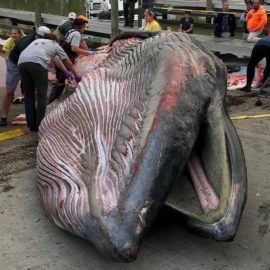
A robot will be in the Gulf to check temperatures for heat and how they help hurricanes.
A deep-diving robot will scour the Gulf of Mexico over the next year in search of under water heat waves that can cause hurricanes, under a project aimed at understanding how storms feed off of the ocean. Fishing charter Fish Heads LA of Cocodrie has partnered with Seatrec of California, an offshore thermal energy company, to better understand the ocean processes that influence storm activity in the Gulf, representatives announced in June. Fish Heads brought Seatrec’s prototype robot 120 miles off the coast of Cocodrie on May 16 to begin its year-long mission, which will inform subsequent years of research. “There’s very little information below the sea surface,” Seatrec founder Yi Chao said. “That’s why I believe there’s a missing piece for hurricane observation, especially rapid intensification.”
nola.com
Normally a boat would be used but the robot offers advantages over the boat.
Normally, Seatrec would have to request a large, slow-moving research vessel to bring them on a days-long journey into the Gulf and back. However, Chao wanted to get the new robot prototype into the Gulf before hurricane season, which began June 1. With Fish Heads, the trip was planned in a couple of weeks and only took one day in the water, he said. Seatrec’s robot, which can dive down up to 1000 meters, will record the temperature and salinity, or thermal structure, of the upper Gulf repeatedly over the next year, but especially whenever a storm system forms. Scientists already know that when hurricanes pass over a deep well of warm water, they intensify as warm air is pumped through their cores. However, hurricane researchers have gotten most data that confirms this phenomenon from above the ocean’s surface. Seatrec’s robot would dive deeper, potentially collecting more information. Analyzing the upper ocean’s thermal structure allows researchers to better predict how a tropical storm will act, National Oceanic and Atmospheric Administration Hurricane Research Division Director Frank Marks said in a recent interview. “In the ocean, temperature and salinity are linked together, as in the atmosphere, humidity and temperature are linked,” Marks said. “When you’re thinking about mixing in the atmosphere, the thermal and humidity structures determine the type of cloud you’re going to get.”

image from Seatrec
The missing information, which the robot should provide, would explain better why some storms intensify faster than others.
In the past, some storms have defied expectation because there wasn’t enough information on how the ocean was affecting certain systems. When Hurricane Ida formed last fall, it began rapidly intensifying as it neared Louisiana’s shore, with wind speeds exceeding those that the National Hurricane Center had forecasted. The center has been working to revamp its hurricane prediction models for the past three years. NOAA has also begun in recent years to use similar robots, called sail drones, to survey the ocean in this capacity. These drones usually dive to about 600 meters below sea level to collect data on the upper ocean. However, those drones must return the ocean’s surface to send back data they have collected, trips that quickly drain their batteries. Seatrec’s robot would have a much longer battery life, Chao said, because it uses thermal technology to convert warm ocean currents into electricity. The prototype will sit 700 meters below sea level in the Gulf, collecting data on the thermal structure of the top 100 meters of ocean water. Chao hopes to sell his technology after testing the prototype this year, he said.

image from Seatrec
The owners of the boat have had experience in doing this type of research before.
Seatrec linked up with Fish Heads at the recommendation of International Game Fish Association species angler Steve Wozniak, who has caught over 2,000 species of fish. The association has also used Fish Heads’ boats for research and species fishing. Fish Heads owner Lane Wall said he was happy to help, as hurricanes have become an ugly fact of life in Louisiana, upending lives regularly with the damage they cause. “We’re in favor of any kind of hurricane research, because (hurricanes have) so much impact on us,” Wall said, adding that one of his employee’s homes got blown away during Hurricane Ida last year. Frequent storms, or the threat of them, have also caused him to lose business. “We had to break the camp down, and move all of our boats and equipment out of there seven times for false alarms,” he said.
My first assignment out of the Coast Guard Academy was on a weather ship where weathermen launched balloons to go into the atmosphere and broadcast data back to earth. This is the same operation only in the reverse direction.



